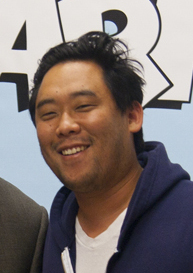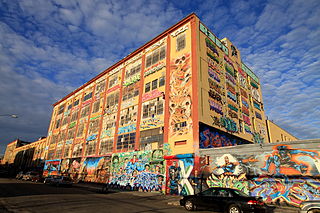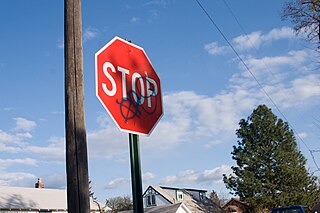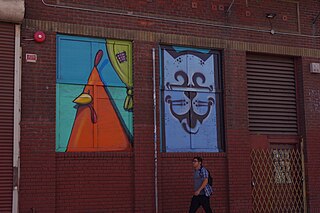
Graffiti is writing or drawings made on a wall or other surface, usually without permission and within public view. Graffiti ranges from simple written "monikers" to elaborate wall paintings, and has existed since ancient times, with examples dating back to ancient Egypt, ancient Greece, and the Roman Empire.
Daniel "Chaka" Ramos is an American graffiti artist. He was responsible for the "CHAKA" tags that began to appear throughout the state of California during the late 1980s and early 1990s. He has been described as one of the most profilic graffiti writers on the late 20th century.

The 38th Street Gang is an American criminal street gang in Los Angeles, California, composed mainly of Hispanic-Americans. The 38th Street Gang is one of the oldest street gangs in Los Angeles and has been occupying its territory since the 1920s. They engage in many criminal activities. The Mexican Mafia controls and routinely uses 38th Street gang members to carry out their orders.
The Jungles faction of the Black P. Stones street gang is a "set" of the Bloods gang alliance in Los Angeles. Originating in Los Angeles' Baldwin Village neighborhood in the 1960s, the Black P. Stones became one of the largest gangs in the city. The gang has been linked to various crimes, including murders, assaults, robberies, narcotics violations and firearms violations, and has been the subject of numerous FBI and LAPD investigations.

David Choe is an American artist, musician, actor, and former journalist and podcast host from Los Angeles. Choe's work appears in a wide variety of urban culture and entertainment contexts. He has illustrated and written for magazines including Hustler, Ray Gun and Vice. He has an ongoing relationship with the Asian pop culture website, store, and former magazine Giant Robot.
Saber is an American graffiti artist and muralist.

5 Pointz: The Institute of Higher Burnin' or 5Pointz Aerosol Art Center, Inc., mainly referred to as simply 5 Pointz or 5Pointz, was an American mural space at 45-46 Davis Street in Long Island City, Queens, New York City. When the building opened in 1892, it housed the Neptune Meter factory, which built water meters.
RISK, also known as RISKY, is a Los Angeles–based graffiti writer and contemporary artist often credited as a founder of the West Coast graffiti scene. In the 1980s, he was one of the first graffiti writers in Southern California to paint freight trains, and he pioneered writing on "heavens", or freeway overpasses. He took his graffiti into the gallery with the launch of the Third Rail series of art shows, and later created a line of graffiti-inspired clothing. In 2017, RISK was knighted by the Medici Family.

Graffiti are writing or drawings scribbled, scratched, or sprayed illicitly on a wall or other surface in a public place. Graffiti ranges from simple written words to elaborate wall paintings. Graffiti, consisting of the defacement of public spaces and buildings, remains a nuisance issue for cities.
Cyrus Yazdani, known by his tagger name Buket, is a graffiti artist who came to prominence after a YouTube video showed him tagging above a Los Angeles freeway in broad daylight.

Graffiti in New York City has had a substantial local, national, and international influence.

Metro Transit Assassins, also known by the initialism MTA or as Melting Toys Away and Must Take All, is a graffiti street artist collective based in Los Angeles, most famous for its half-mile graffiti "MTA" tag along the concrete walls of the Los Angeles River.
Jose "Prime" Reza, is an American graffiti artist born and raised in the Pico-Union District of Downtown Los Angeles. Prime is credited with being a founding father of Los Angeles stylized graffiti lettering, a hybrid of Cholo lettering and East Coast style graffiti that is often bold, aggressive, and monochromatic.
Roger Gastman is an American art dealer, curator, filmmaker, and publisher who focuses on graffiti and street art.

Stefano Bloch is an American author and professor of cultural geography and critical criminology at the University of Arizona who focuses on graffiti, prisons, the policing of public space, and gang activity.

Rick Ordonez, also known as Atlas and known colloquially as the "kitty cat tagger," is an American graphic designer and graffiti artist from Alhambra, California.
Torrick Ablack, also known as Toxic, is an American artist who was part of the graffiti movement of the early 1980s in New York City. He transitioned from street art to exhibiting his paintings in galleries and museums internationally.
Jason Wulf was a Queens-based graffiti artist. He worked as a carpenter and sign painter.

Danielle E. "Utah" Bremner and Jim Clay "Ether" Harper VI are American graffiti artists, dubbed the "Bonnie and Clyde of the graffiti world". They have tagged trains and buildings in over 30 countries on five continents, and have made books and videos about their exploits. They have also been arrested, fined, and served multiple prison sentences for vandalism. Their use of social media has been used as an example in a book about graffiti artists, and they have been the subjects of a video exhibit and a song.











